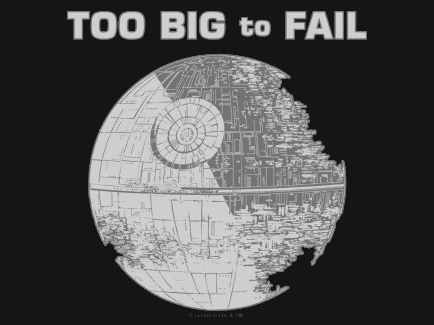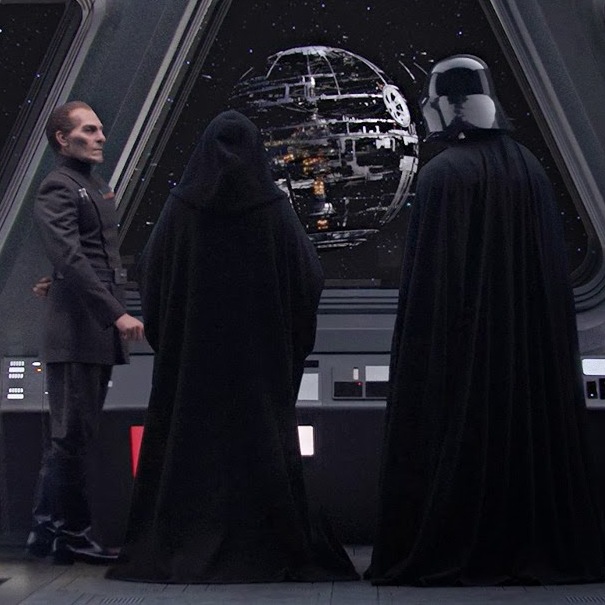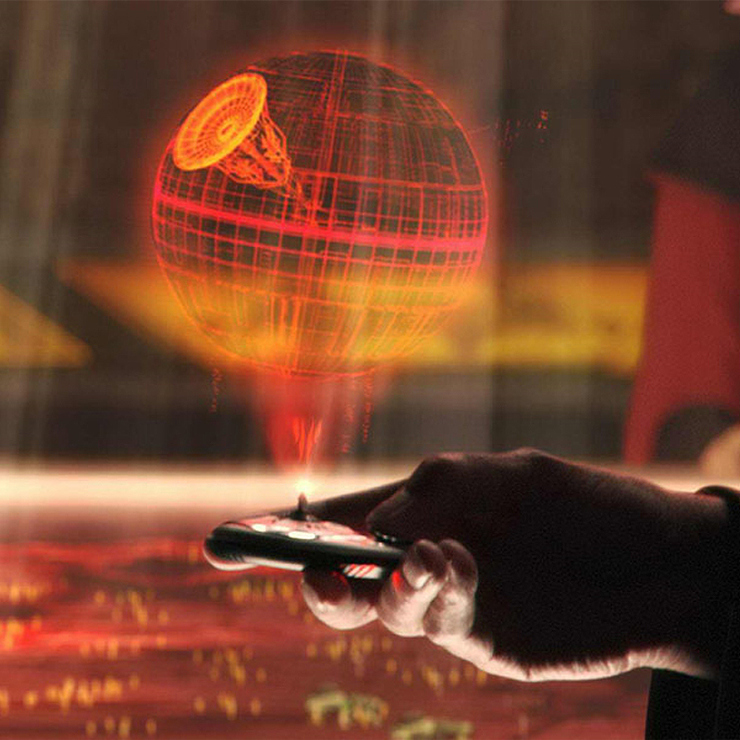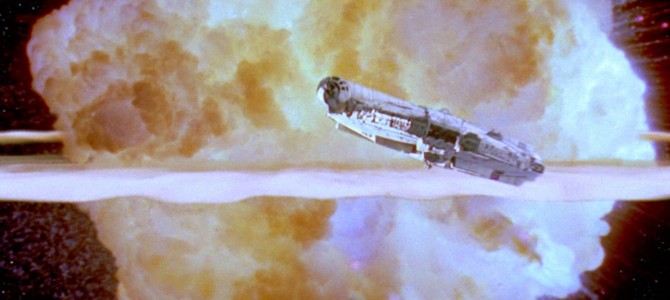“Great shot, kid! That was one in a million!” Han Solo famously tells Luke Skywalker after the latter blows up the first Death Star.
But that’s not exactly right. It’s more like one in every third Star Wars movie.
The debut teaser trailer for “Rogue One: A Star Wars Story” is out, and it seems gritty, action-packed, and pretty great — at first glance, even more promising than “The Force Awakens.” But the hitch, it seems, is that we’ll once again be subjected to the laziest plotline in the Star Wars narrative: the menace of the Death Star (or the menace of the Death Star-like star-killing space station.)
 This time around, from what I can tell, a Rebel squad — comprised of some attractive-but-unruly hipsters and (maybe) a galactic ninja — are tasked with stealing the plans for the Empire’s plodding, ill-conceived, easily destroyed giant death machine. “Rogue One” looks to bridge the messy prequels and crisply plotted Episode IV.
This time around, from what I can tell, a Rebel squad — comprised of some attractive-but-unruly hipsters and (maybe) a galactic ninja — are tasked with stealing the plans for the Empire’s plodding, ill-conceived, easily destroyed giant death machine. “Rogue One” looks to bridge the messy prequels and crisply plotted Episode IV.
How many times will the franchise pull from this well? A Death Star is an irrational waste of human capital, military resources, and raw material. Yet, most of the movies in the Star Wars franchise touch on its existence or threat or formation.
A Death Star disaster is visited upon us twice in first three films. As a kid, I remember being confused about the construction of a deadlier Death Star in “Return of the Jedi.” Only a few years earlier, an untrained X-wing pilot atomized the entire moon-sized compound with a couple of proton torpedoes and no targeting computer. (Luke, incidentally, could have accomplished the feat before he learned about The Force. You’ll remember him humiliating Wedge at the planning meeting: “I used to bull’s-eye womp rats in my T-16 back home. They’re not much bigger than two meters,” he boasts. All you need is a high midichlorian count, apparently. But let’s never speak about chemistry again.)
One imagines millions of imperial troops and civilians (engineers, support staff) perishing in this needless debacle; clones aren’t exactly cheap, even if we set aside the moral cost of putting so many lives in pointless peril. And who knows how much brain power, leadership, and innovation were lost? It was mere luck that the emperor wasn’t on the base.
Then, of course, the prequels, already weighed down with impenetrable plotlines, gave us another reason to chuckle when Episode II revealed that flying bug alien separatists and Count Doku were conspiring to build the “ultimate weapon” that we know is going to be blown to bits — twice.
Strategically speaking, puttin g all your eggs in one gigantic metallic spherical basket is counterproductive. Perhaps in its initial phase, the Death Star (boy, the Empire sure could have used an Orwellian touch when naming things) might have kept breakaway planets in line through intimidation. But by the time the station was operational, the Rebellion (the “civil war” in the opening crawl) was already in full force. Tarkin even tells his fellow generals that an operational station would “crush the Rebellion with one swift stroke.”
g all your eggs in one gigantic metallic spherical basket is counterproductive. Perhaps in its initial phase, the Death Star (boy, the Empire sure could have used an Orwellian touch when naming things) might have kept breakaway planets in line through intimidation. But by the time the station was operational, the Rebellion (the “civil war” in the opening crawl) was already in full force. Tarkin even tells his fellow generals that an operational station would “crush the Rebellion with one swift stroke.”
Which is lunacy.
The Empire has no understanding of how to deal with a nimble guerilla force or run galaxy-wide counterinsurgency. Just look at the military hardware they employ: AT-AT Walkers, for instance, featured in the “Rogue One” trailer, make absolutely no functional sense whatsoever. Moreover, a giant space station is a blessing for the Rebels, who can now concentrate on a massive target and become less susceptible to one “swift stroke” themselves. Plodding easily detectable giant objects that seem to take hours to power up a giant canon are easy to avoid.
As blogger Seth Masket explained a few years back:
Now, just as building a Death Star sent an important message to non-compliant planets, destroying a Death Star sent a powerful signal, as well. It was a huge public relations coup for the Rebellion. So the Death Star, while a devastating weapon, was also a tempting target. There were some basic conceptual design flaws (both versions were destroyed by a small smuggling ship and a handful of single-person fighters), but really, even if it had survived Yavin, it was doomed to spend much of its operational time fighting off attackers, simply by virtue of being such a big fat target.
And though planet-crushing weaponry may terrify governments, it won’t work with the zealots of the Rebel Alliance. Princess Leia allowed General Tarkin to annihilate her home planet of Alderaan — billions of people lost — to protect a couple of robots in possession of Death Star blueprints. She could have made a copy and thrown it in the mail.
From an economic point of view, one can imagine what kind of bureaucratic mess comes with building a planet from scratch. As John Hayward recently pointed out, the Death Star might be the most expensive public works disaster in galactic history. A few years ago, some Lehigh University students estimated that the steel alone would have cost around $852 quadrillion or “13,000 times the current GDP of the Earth” — which seems to underestimate the vastness of the project. The labor costs? Judging from the prequels, there are scarcity issues in the galaxy, trade unions, and blockades. And you can imagine the corruption on a project of this size.
 And yet, this disaster is going to happen again. “The Force Awakens” is basically a reimagining of the original Star Wars story with the Starkiller Base standing in as an amped-up version of the Death Star.
And yet, this disaster is going to happen again. “The Force Awakens” is basically a reimagining of the original Star Wars story with the Starkiller Base standing in as an amped-up version of the Death Star.
According to the Star Wars website, the First Order (more of a cash-strapped startup operation) has “an ice planet converted into a stronghold,” and it is “armed with a fiercely destructive new weapon capable of destroying entire star systems.” It makes a lot more sense to embed the weapon into a planet, but the fundamental problems remain. Also, a new one emerges: mobility.
“The Empire Strikes Back,” for good reason, is generally considered the best movie in the franchise. It’s worth pointing out that it did not have a Death Star. I suspect “Rogue One,” like many other Star Wars movies, will transcend its subpar script. With the considerable technical and storytelling talents of the filmmakers drafted to make the new batch of films and the entire canon to mine for material, it might be time to let go the Death Star or the Starkiller or the Galaxymurderer or whatever super weapon is next on the docket. It’s a stupid idea unworthy of this much cinematic attention.









